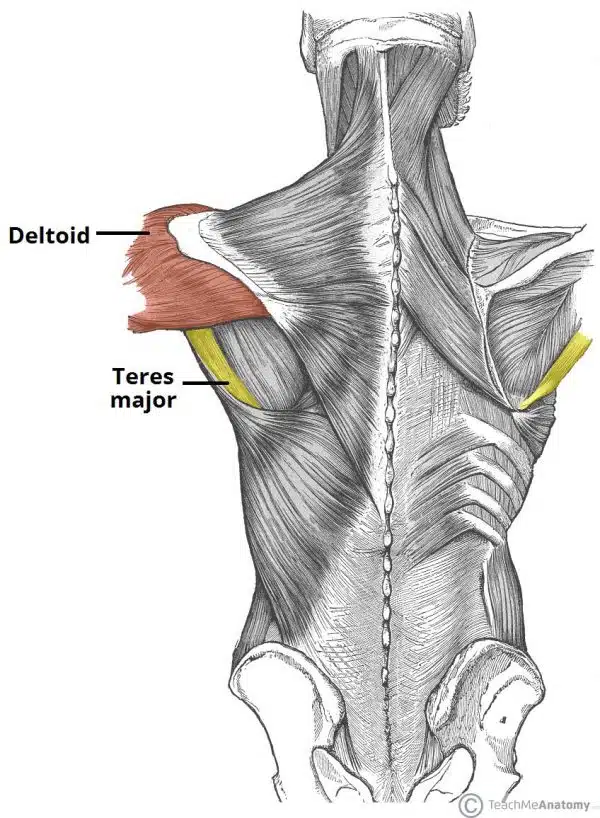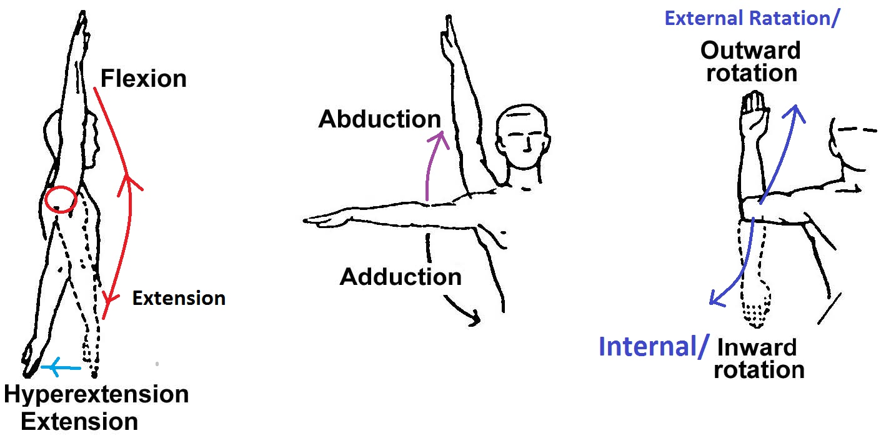If you want to get some capped, round, cannonball, Death Star shoulders that’ll cause another solar eclipse, then you gotta train the often forgotten part of the shoulders – rear delts! The rear delts make up ⅓ of your entire shoulder and it cannot be neglected if you want to maximize your shoulder gains. Luckily, this guide will show you how to develop your shoulders in the most effective way possible, all with just rear delt dumbbell exercises.
Rear Delt Anatomy
The deltoids (your shoulders) are made up of three muscles – the front, middle, and rear delts. Like their names suggest, the front delt is located in the front of the shoulder, with its origin found on the lateral third of the clavicle. The middle delt, on the side of your shoulder, originates on the acromion of the scapula. And the rear delts originate on the posterior side of the scapular spine of the scapula. Despite having different origins, they all insert into the deltoid tuberosity found on the side of your humerus (your upper arm bone).

All of these different origins enable the shoulder to perform many different functions.
- The front delt performs shoulder flexion and internal rotation.
- The middle delt performs shoulder abduction – bringing your arm out to the side.
- The rear delt performs shoulder extension and external rotation.

Since the rear delts are responsible for shoulder extension and external rotation, the best way to strengthen and grow them is with movements that do just that. Overloading these movements over time will give you a first-class ticket to those boulder shoulders you’ve always wanted.
Why You Should Train The Rear Delts
Before we get into the best exercises to target your rear delts, you should know why it is important to work them. Many people tend to neglect the rear delt since it’s such a small muscle and you can’t even see it without a mirror (After all, out of sight, out of mind …right? No).
Despite it not being a show muscle like your chest or biceps – it’s crucial that you train your rear delts for two main reasons.
1. Posture/Shoulder Health
If you are like most gym bros, you probably do lots of pressing movements in your routine – bench press, overhead press, dumbbell press, push ups, dips, etc. These movements are great for your chest, triceps, and front delts, but if you neglect to perform the opposite movement pattern (horizontal pulling), you’ll have overdeveloped front delts which can result in kyphotic posture, similar to a gorilla.

While having your physique compared to a gorilla might sound cool, your shoulders will be paying the price for that look. Underdeveloped and weak rear delts can lead to injury over time and will make it harder to stabilize your scapula during all of your pressing movements. That’s why it’s crucial that you don’t overlook the small, non-showy muscle groups, like the rear delts and make them a staple of your training.
2. Aesthetics
Ah, the reason you’re probably most concerned about. The rear delts are crucial to developing an aesthetic physique. They round out and complete your shoulder development, especially when someone sees you from the side or the back. The rear delts are what really gives your shoulder that Death Star pop you are looking for.

Training your rear delts will also help with developing your v-taper. Having broader shoulders is never an issue and adding to that look by having developed rear delts will not only make your shoulders look more impressive, but will make your waist look smaller which will make your physique more impressive as a whole.
Now that you know how important training your rear delts are, let’s get into the best exercises to target them.
Rear Delt Dumbbell Exercises
1. Bent Over Rear Delt Fly (Standing)
A staple exercise in the routines of many of the best bodybuilders of all time is the bent over rear delt fly. To execute this movement, grab a pair of dumbbells in both hands and while keeping your core tight, you want to hinge your butt back until your back is about parallel with the ground. Maintain tension in your core and glutes while in this position. From here, similar to a dumbbell row, you want to pull your elbows back as high as you can while maintaining about a 90-degree bend in your arms. Make sure to keep your arms wide to target the rear delts rather than keeping them close to your sides like in a dumbbell row. This will really target the rear delts as you are performing their primary functions – shoulder abduction and extension.
2. Bent Over Rear Delt Fly (Seated)
Similar to the standing variation, here we perform the movement while sitting on a bench. Just like in the standing variation, remember to keep your core tight, maintain a 90-degree bend in your arms, and focus on bringing your shoulder back behind you to get a good contraction in those rear delts on every rep.
Programming and Tips for Progression
1. Frequency
If your rear delts are a weakness in your physique, you can train them as often as every day. The rear delts are a small muscle group, so they can recover quickly and will be able to handle the high frequency. However, if your rear delts are not a huge priority for you to bring up, but you still want to make gains, 2-4 times a week of 3-5 sets is a good sweet spot in terms of frequency.
2. Sets & Reps
Like I discussed in the frequency section, the rear delts are a small muscle group, so it would be unwise to train them directly with anything less than about 10 reps. Going heavy with such a small muscle group can put you at risk of injury. That’s why when directly isolating your rear delts, like with the exercises I listed above, anywhere from 2-5 sets in the 10-20 rep range is best.
3. Train them heavily… indirectly
Performing the rear delt exercises I listed above with sets of five reps is a bad idea, as that’ll place a lot of stress on a small muscle group. If you want to train the rear delts heavy, the best way to go about it is to perform heavy horizontal and vertical pulling movements on your back/pull days. As long as the rest of your back days include some sort of horizontal and vertical pulling in the single-digit rep ranges, your rear delts will get enough indirect heavy stimulation from exercises like the weighted pull-up and barbell rows, so you don’t need to directly train them heavy. This will mitigate the risk of injury to your rear delts while also providing an indirect heavy stimulus which will contribute to it getting bigger and stronger. A win-win!

4. Progression Schemes
Like with many other small, isolation movements, a double progression (like I discussed in the oblique training post here) or a dynamic double progression scheme works best. In a double progression, you would pick a rep range and stick with the weight you use for that rep range until you reach the high end of that rep range for all sets with that exercise before adding weight. A dynamic double progression is similar, except you increase the weight on a set-by-set basis, rather than waiting until you reach the high end of reps in ALL sets before adding weight. Below is an example of double progression and dynamic double progression using the standing bent over rear delt fly as the exercise of choice.
Double Progression – 3 sets of 10-15 reps
- Week 1: 3 sets of 12, 12, 12 reps with a 10 lb dumbbell
- Week 2: 3 sets of 13, 13, 13 reps with a 10 lb dumbbell
- Week 3: 3 sets of 14, 14, 13 reps with a 10 lb dumbbell
- Week 4: 3 sets of 15, 15, 15 reps with a 10 lb dumbbell
- Week 5: 3 sets of 10, 10, 10 reps with a 15 lb dumbbell
Dynamic Double Progression – 3 sets of 10-15 reps
- Week 1: 3 sets of 12, 12, 12 reps with a 10 lb dumbbell
- Week 2: 3 sets of 13, 13, 13 reps with a 10 lb dumbbell
- Week 3: 3 sets of 14, 14, 13 reps with a 10 lb dumbbell
- Week 4: 3 sets of 15, 14, 13 reps with a 10 lb dumbbell
- Week 5: 3 sets of 12, 14, 14 reps with a 15 lb dumbbell for the first set and a 10 lb dumbbell for the second and third sets
Since you hit the high end of the rep range on the first set in week 4, you would increase the weight you are using in the following week. You would stick with 10 lbs for the second and third sets because you haven’t hit the high end of the rep range yet.
Closing Remarks
As you can see, getting bigger rear delts is not all that complicated. Just make sure to isolate them directly with the exercises I listed above in the higher rep range, continue doing your heavy horizontal and vertical pull movements, get stronger at these movements over time, and you’ll be well on your way to getting those Broly shoulders!

If you’re looking to take your training to the next level and get personalized one-on-one coaching from Coach Jay, check out my 10 Week Physique. You’ll receive a personalized training program, nutrition guide, and more! Check it out here!
